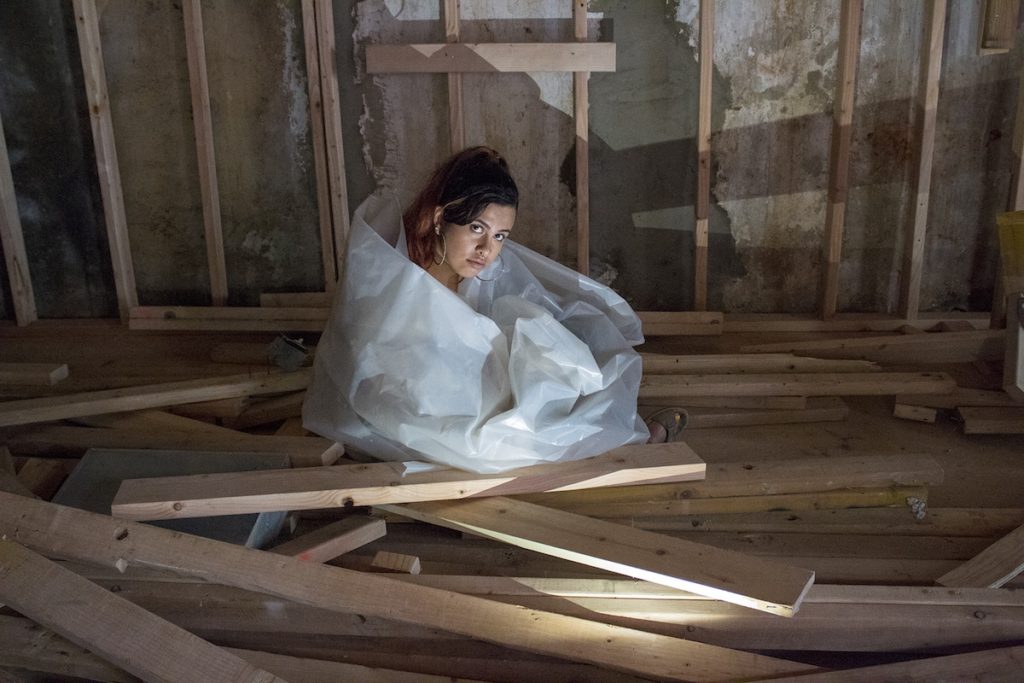How Women’s Mobile Museum is making non-traditional artists’ work accessible
 October 29, 2018
Category: Feature, Featured, Long, Purpose
October 29, 2018
Category: Feature, Featured, Long, Purpose
In a gutted room, Muffy Ashley Torres placed a yellow sheet in the same spot where their grandmother’s bed once was. They lined the sheet with flowers and wore a matching skirt. Lying on their side, Torres hugged their chest, and stared into a camera.
Later, they titled this self-portrait “La Cama,” which means bed in Spanish. It honors their abuela, who passed a few months ago. Her favorite color was yellow.
Torres said photography helps them process losing the matriarch of their family, and the home they took the photo in.
“Our house was destroyed,” they said. “It was destroyed due to gentrification and cheaply made buildings that are copy and pasted and just quickly manufactured. … One of those buildings toppled onto our family house,” which was demolished two weeks ago. It took their father eight years to build it; the family lived there for 12. They are now displaced in two separate apartments.
Torres is an artist for the Women’s Mobile Museum (WMM), a project of the Philadelphia Photo Arts Center (PPAC) — the same nonprofit behind 2016’s Philly Block Project in South Kensington — that questions who art typically serves.
Under the umbrella of WMM, South African photographer and activist Zanele Muholi has a yearlong artist residency. Ten Philadelphia women “who are artists but haven’t been able to access education or professional opportunities” were named apprentices, said Lori Waselchuck, PPAC’s exhibitions and programs coordinator.
The women’s work is shown in WMM’s traveling exhibits, the second of which opened on Saturday. The Dixon House in Point Breeze will host WMM — which includes Torres’ “La Cama” — through Nov. 17.
The museum is also the first PPAC project that’s accessible to visually and hearing-impaired audiences, Waselchuck said. Sr. Elaine George of the Saint Lucy Day School for Children with Visual Impairments taught the WMM artists techniques that allow visitors who are blind or deaf to experience their art.
“We do believe that art is for everyone, and it just … made that conversation bigger,” Waselchuck said. “It increases our responsibility to continue to think through access and make sure that we can offer access when possible.”
George was introduced to WMM through the Juniata Action Committee (JAC), where she serves as president. Waselchuck reached out to JAC about a year ago to coordinate a showing in Juniata. WMM’s community shows opened in the neighborhood at the Juniata Park Boys and Girls Club in September.
During a meeting at the Saint Lucy Day School, George asked Waselchuck, “Could we make this exhibit accessible to the blind? Would you be willing to do that?” George recalled. The result “was above and beyond my expectations of what could have been accomplished. They really took it to the next level. I was amazed.”
Some of the accessibility techniques used by WMM include:
- Audio descriptions recorded by the artists about their pieces that included the title of the photo, its subject, prominent features and the general emotion or message being conveyed; they also recorded their artist statements
- Physical representations of the pieces that can be touched
- Braille titles of pieces
The nearly 40 students of Saint Lucy Day School ranging from pre-K to eighth grade visited WMM at the Juniata Park Boys and Girls Club on Oct. 9.
“A lot of times when they go to a museum, things are behind glass, you’re not allowed to touch it,” George said. “They can’t access that information with Braille or with an audio description, so they were very impressed that this museum was at some level accessible to them.” She encouraged other museums to employ similar tactics.
WMM’s focus on accessibility resonated with Torres because of their experience with lupus, a chronic autoimmune disease that has symptoms like tiredness, light sensitivity and pain. During chunks of time they were unable to meet in person because of symptoms, the other artists and PPAC were supportive, they said.
And at the first community show, Torres said, some visitors stayed for up to two hours to discuss the art and their similar experiences with the artists. They sensed WMM and its community showings inspired more conversations like that than more traditional museums would.
“Those exchanges and those ways that this project has brought people together,” Torres said, “that is what art is to me.”
Trending News










